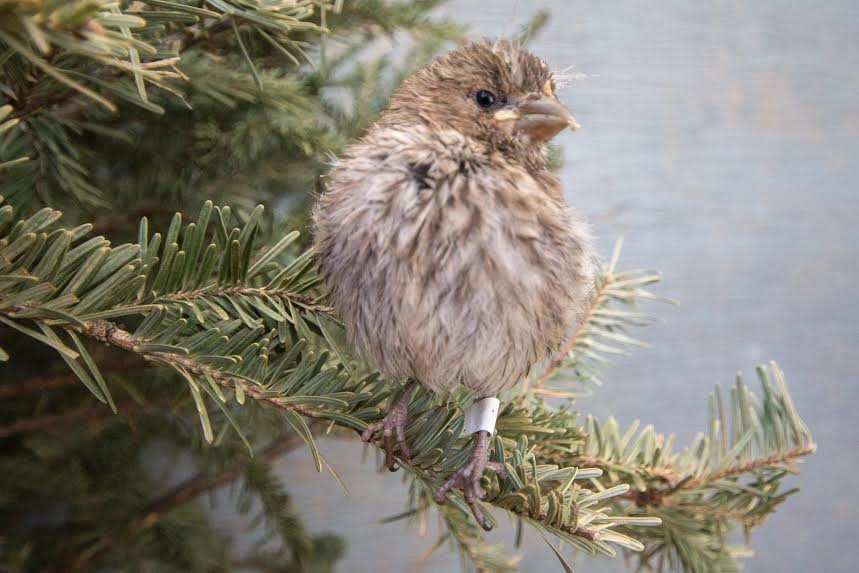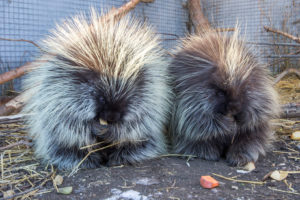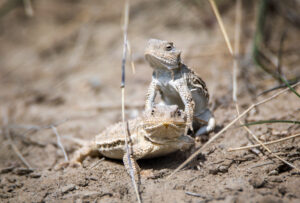They’re tapping at our windows, singing us morning songs and tantalizing Alberta’s felines, but who exactly are these little feathered friends? Aside from the obvious red-breasted robins or black-capped chickadees, how much do you know about Alberta’s most common birds?
Below is a brief introduction to Alberta birds! Be prepared to wow your friends with your bird knowledge!
Sparrow
House sparrow: House sparrows are chunky with full chests, rounded heads and stout bills. Males have gray heads, white cheeks, black bibs and reddish-brown necks, while females are a more dull brown. These sparrows are noisy and come out of their nest holes to pick at crumbs or seeds. They’ve been tolerating humans for centuries and are now quite comfortable hanging out on city streets, zoos, parking lots or more.
American tree sparrow: These plump little sparrows keep busy in the winter months, hunting for seeds, weeds and grass heads. In the springtime, these little sparrows head even further north to their breeding grounds in the tundra. You will recognize an American tree sparrow by his rusty cap and eyeliner on a gray, chubby-looking body.
White-throated sparrow: These are flashy little sparrows with spunk to match. They have black and white striped heads, bright white throats and yellow between the eye and bill. To identify a white-throated sparrow, look for a prominent bill, long legs and a narrow tail. You’re most likely to find these little sparrows in wooded area and forest edges. In the winter, they often nest in parks and woodsy suburbs.
Chickadee
Black-capped chickadee: No one can resist these undeniably adorable little birds. Black-capped chickadees have tiny bodies, oversized heads and big eyes. With a black cap and bib, this chickadee is easy to find and is usually happy to investigate people while searching out seeds, berries and birdfeeders. Often nesting in birch or alder trees, black-capped chickadees stay in Alberta year round.
Boreal chickadee: You aren’t likely to find one of these brown-capped chickadees in Southern Alberta. They are one of the only birds that live completely within the biome of the northern boreal forest. They have brownish caps and bibs and white cheeks.
Finch
House finch: The house finch has a bright red head and breast with brownish wings and body. Even if you’ve never seen one of these little finches, you’ve probably heard them! Their long, twittering song is heard in neighbourhoods around North America. These little birds are cheerful and like to frequent birdfeeders, just like the little chickadees! They are hardy birds too, happy to make homes in urban and rural areas or in their native habitats of deserts, grasslands and open forest.
Purple finch: You’re most likely to see one of these strawberry-coloured finches in the winter, when they come by to feed from birdfeeders. It’s easy to mix them up with the house finch, but look closely at their colouring and you’ll notice that the red-pink of their faces mixes into the brown and white of their bodies in an almost ombré-toned manner.
Nuthatch
Red-breasted nuthatch: These are active, hoppy little birds that make a “yank-yank” sound as they search tree bark for hiding insects. These tiny nuthatches have short tails, a plump body and almost no neck! They are blue-gray in colour with black caps, white stripes above their eyes and a rusty-red underbelly. Look for these bubbly little birds among spruce, fir, pine, hemlock, and poplar trees.
White-breasted nuthatch: Like their red-breasted friends, these nuthatches are full of energy, springing through backyards as they search for bountiful birdfeeders. Do you wonder how the nuthatches got their name? They like to take large nuts and acorns and ram them against trees until the seeds “hatch.” That’s exactly what you can find these black, blue-gray and white nuthatches doing along woodland edges.
Now that you have a very brief introduction to the types of feathered backyard visitors in Alberta, you can share your knowledge! The more you learn about the beautifully diverse, intricate species that inhabit our province, the more you will appreciate the natural world.
Do you want to help AIWC in its mission to conserve, rehabilitate and spread awareness of Alberta wildlife? You can volunteer, donate and much more. For more information on how you can support AIWC, visit https://www.aiwc.ca/support-us/
“Nature is not a place to visit. It is home.”
-Gary Snyder
By Nina Grossman, AIWC Volunteer







23 thoughts on “Birds of a Feather: Some of Alberta’s Most Common Bird Species”
I am a farmer at Hanna.
I saw a bird today I have never seen before.
It was the size of a large sparrow or small starling.
All black except for white stripe on back and white tail feathers. Seemed to have a buff cap on back of head. Bird was out in the open in an alfalfa hay field.
Any ideas?
Hello Norman,
Thank you for getting in touch. It’s hard to picture what kind of bird that could be. This is a great resource for identifying birds: https://www.allaboutbirds.org/guide/search/ Hopefully this can help. All the best, thank you 🙂
i live outside of rocky mountain house and have a “varied thrush” visiting my feeders. this will be the 3rd or 4th year.
That’s so great to hear! 🙂 Thank you for sharing.
I live in Barrhead Alberta and for some reason we have not seen any sparrows this winter…did they die from a virus or just naturally …..usually we have to fill our feeder every second day but this year it has hardly been touched. The only birds we see are crows and the odd magpie….Hooray just saw two robins just now…hope more birds will show up
Wondering if there is a species of bird new to the Edmonton area that is very shrill. Sounds like the modern fire alarm, every morning since mid-April. I haven’t noticed it before. I think it might be a bit bigger than a sparrow, and have 2 white stripes on its tail feathers if it’s the same bird I hear and then visits my feeder. Hard to say if it’s the loud one, or just in the yard at the same time.
We were up around beaverhill bird Observatory and saw 2 male bobolink are they common in this area first time we ever saw one
That is so cool! Thanks for sharing!
On May 24 I briefly saw a small pudgy bird with a bright yellow chest which I have never seen before. I know it did not have any black coloring, so the rest of it’s coloring was softer. The yellow was very distinct. Any ideas?
Red Deer, AB – Had about 15 birds descend on our trees (spruce, silver maple) and small pond in our backyard. Had navy blue iridescent heads; bronze and black body with a slight lighter marking mid-wing; slightly smaller than robin; bright yellow beaks, some with black beak; dark tail feathers; appeared to be eating bugs on branches of spruce, and maples; swam in the pond, picking seeds or bugs from between slate. ??
Hello,
This is a great website to help with bird identification: https://www.allaboutbirds.org/ This should be able to help you identify these birds 🙂 Thank you!
What about mourning dove? They live here in abundance.
Hello, that’s great you are seeing so many of them. It really depends on the area, they are more common in some areas than most.
A bird about the size of a robin ran into my living room window and stunned itself. it had a bright orange “v” on its neck and was speckled for the most part with some yellow.
I keep blinds at least partly down on my windows so the birds can detect the glass, especially at night as I’ve had a few bird/window collisions in the past too. Pretty sad.
We have a few Spruce Grouse living in the community (SW Calgary), always a dramatic event when they decide they have to blow their cover. I’ve seen another smaller blue/grey hawk this summer that sounds a lot like a red-tailed hawk- possibly a Cooper’s Hawk.
Anyone know if I would have seen a crane, heron or egret at Harlech Pond outisde of Nordegg? I am unable to find exactly what it would have been.
Hi Mike, most likely a heron. Do you have any photos?
I have a small baby bird that kind of flew and crash landed in my room. I tried to get him to fly away, but he only got about a foot in the air and then hit a fence. Then he burrowed under some grass along the fence and stayed there. I was afraid he’d get eaten so I took him in. I dont know what to feed him so any help you can give I would appreciate. Sincerely Stacey. [email protected]
If you haven’t already, please call our Wildlife Hotline at 403-946-2361 so we can better assist you over the phone. Thank you!
Saw a larger perching bird in the Oldman River valley. Completely rust coloured, spreads it’s tailfeathers noticeably when it flies. A larger looking song bird, if in fact it is one. Any ideas?
Hi Phil, could be a Brown Thrasher. Have a look on https://www.allaboutbirds.org/news/ to see if you can spot a similar looking bird 🙂
I work north West of Fort McMurray , I often see flocks of small brown birds with white under bellies. They fly in front of the vehicle and criss cross in front of it at a very high speed Several times. Can you assist me with what this species is called. They are beautiful to watch.
Hi Cail, it’s a bit hard to say without a picture. If you can send one to us at [email protected], we’ll do our best to help you with an ID!